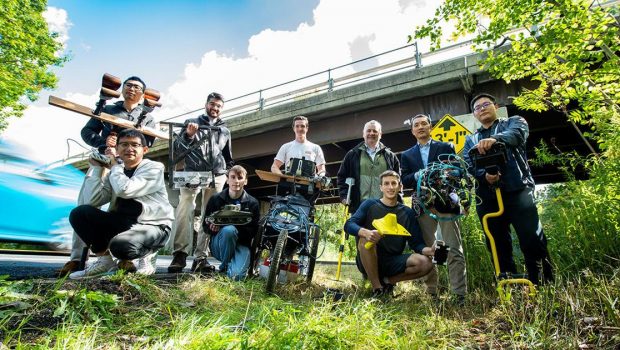Two Vermont colleges are recipients of a grant to develop and test new technologies to monitor infrastructure, as well as train the workforce that will eventually use them.
The University of Vermont and Vermont Technical College, along with the University of Maine, received a $4 million research infrastructure grant from the National Science Foundation to develop and deploy new wireless sensor technologies that could make monitoring the safety and performance of built infrastructure more affordable, accurate and accessible.
Through the four-year project, the three schools also will address human infrastructure needs by creating a trained workforce that will know how to design and manufacture the new technologies the project will develop.
Dryver Huston, professor of mechanical engineering at UVM, called the technology a “game-changer.”
The next generation sensors, which will use 5G wireless data networks, will be easily and affordably embedded in existing infrastructure and built into new projects in order to relay valuable data about structures in real-time.
Currently, only large-scale infrastructure is able to employ such technologies to guard against catastrophic failures. The current generation of sensors used on such structures transmit data via fixed, wired systems that limit their placement.
However, Huston explained, these new, user-friendly sensors will be accessible to smaller municipalities, like those in Vermont and Maine. The use of artificial intelligence-enabled robots will allow sensors to be placed in difficult to reach locations.
Over the next couple decades, Huston said he anticipates these new technologies will begin to be embedded in small-scale infrastructure.
For example, smaller cities like Rutland or Brattleboro could monitor the stability of a slope to see whether it’s prone to landslides or see whether a stormwater system is prone to flooding.
Huston said that while the individual components exist, UVM students will be building the new sensors and networks from the ground up.
Equally important, according to Huston, is the opportunity to train workers who can use these new tools.
“The big component of this will be workforce development and education, starting even at the K through 12 level all the way up to the (doctorate) level,” he said.
As part of the project, the schools will identify four or five pilot sites between Vermont and Maine where the new tech will be used for both research and education.
Sites will include coastal structures, such as wind turbines and estuaries; subsurface infrastructure like water and sewer pipes, telecommunications and power grids, culverts and tunnels; highway structures, like roads, bridges and overpasses; and installations on mountains and hillsides.
Huston explained how students in grades K-12 will be able to access visit the “test beds” to see how the sensors are deployed in the field, as well as analyze data and observe weather events, such as floods, which, thanks to wireless technology, can be accessed remotely from the classroom.
Huston said engineering students working on the project will gain experience in designing and using emerging technologies that are on track to becoming ubiquitous in a number of industries.
“I think this notion of wireless sensing and digital transformation is rolling across virtually every field,” he said.
He explained that while the project is focusing on built infrastructure, he anticipates applications in the medical and manufacturing fields, as well as smaller start-ups that would want to use these tools to become more competitive.
“This is where the human infrastructure comes into play. Not only are they cheap, but we’ll have people that know how to use them,” he said, noting that municipal employees can be easily trained to use these tools rather than bringing in a specialized technician.
Understanding cybersecurity also will be critical. When dealing with the transmission of large amounts of critical data, Huston stressed the need to make sure the wireless systems being used are secure from external threats.
“The plan is not to do cybersecurity as an afterthought but to integrate that right in the beginning,” he said.
Mary O’Leary, chair of the Civil & Environmental Engineering Technology department at VTC, said her school’s role will be focused on the implementation and field testing of the tech developed by UVM students.
“Our students will be able to be implementing this technology out in the field and that will translate perfectly into these new innovative technologies that are happening everywhere out in the industry. So, they’re going to be just even more prepped to do practical work,” she said.
VTC’s scope of work will be looking at stormwater and geotechnical infrastructure, said O’Leary.
While river gauges already are used to measure water flow and flooding, she said the new sensors will be installed in culvert systems to identify risks there, as well. Sensors will also be placed in the ground to monitor incremental changes in the landscape that can lead to landslides.
She said municipalities will be able to use the data to better prioritize what systems need improvements and mitigate potential risks.
As part of the project’s educational outreach component, O’Leary said the new technology will be incorporated into existing VTC engineering camps for students in grades 6-12.
“Just showing (them) how cool all of this technology is,” she said. “It’s one more reason to stay in Vermont. Come to VTC, get a degree and live and work really well here in the state.”
O’Leary said the project strengthens VTC’s mission of offering a practical education that graduates can apply in state.
“We keep Vermonters working and living in Vermont with a really high wage. (When) they get out, they can afford to pay off their student loans, they can get to work and make good money,” she said. “Our students are now going to be exposed to this new technology, which hopefully will be implemented in the field, and they’ll already have all the knowledge on how to implement it.”
jim.sabataso @rutlandherald.com








Gloss